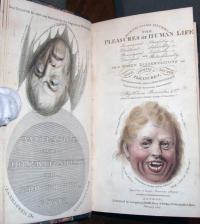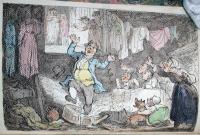

In 1806, Reverend James Beresford (1764-1840) published a series of humorous dialogues entitled, The Miseries of Human Life (Graphic Arts, Rowlandson 1806.3). The book proved so popular that three editions sold out in a matter of weeks.
Several imitations appeared the following year, including Robert Heron’s Comforts of Human Life (Graphic Arts, Rowlandson 1807.4) but the most successful by far was The Pleasures of Human Life published under the name of Hilaris Benevolus and Company, Fellows of the “London Literary Society of Lusorists.” In fact, the book was written by John Britton, a young man whose only other books to date were historical and topographical essays on England.
Britton followed Beresford’s use of dialogues and his use of hand-colored etchings by Thomas Rowlandson (1756-1827), commissioning five prints only loosely connected to the text. The frontispiece literally turns Beresford’s book topsy-turvy, complimented by an illustrated title page, drawn by another popular artist of the time, R. William Satchwell (1732-1811) and engraved by William Bond.
Britton wrote that members of the Society of Lusorists, including Benevolus, Simon Specific, David Demurrer, and others, held meetings to “examine, canvass, and discuss the most noted and popular acts, deeds, and things done, performed, and committed in the British metropolis.” The pleasures are separated between male, female, and neuter, “interspersed with various anecdotes, and expounded by numerous annotations.”
Britton went on to become an celebrated advocate of historic preservation and in 1845, a Britton Club was formed in his honor.